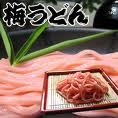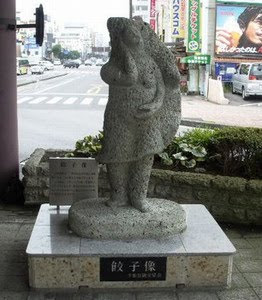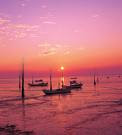::::::::::::::::::::::::::::::::::::::::::::::::::::::::::::::::::::::::::::::::::::::::::::::::::::
Yamanashi Prefecture
Yamanashi Prefecture (山梨県, Yamanashi-ken) is a prefecture of Japan located in the Chūbu region of the island of Honshū. The capital is the city of Kōfu.
© More in the WIKIPEDIA !
::::::::::::::::::::::::::::::::::::::::::::::::::::::::::::::::::::::::::::::::::::::::::::::::::::
Yamanashi Specialities 山梨郷土料理
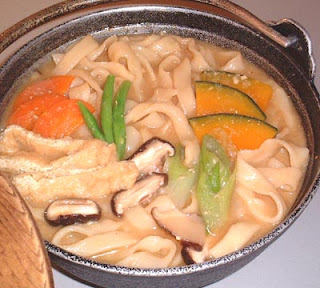
hootoo, Hōtō, hoto ほうとう
Hōtō (ほうとう, Houtou) is a popular regional dish originating from Yamanashi, Japan made by stewing flat udon noodles and vegetables in miso soup. Though hōtō is commonly recognized as a variant of udon, locals do not consider it to be an udon dish because the dough is prepared in the style of dumplings rather than noodles.
Origins
Wheat farming and the flour culture were brought into Yamanashi prefecture due to shortages in local rice crops. Sericulture had turned lands traditionally reserved for rice crops into silk farms, and flour products like hōtō were invented as a means to counter food shortages which arose from this change in agriculture.
This transition may have begun in Yamanashi's Gunnai region, where rice farming was impossible to begin with due to cold temperature and large amounts of volcanic debris embedded into the soil. Wheat farming spread through the rest of the prefecture and into the neighboring Nagano, Shizuoka, Saitama, and Gunma prefectures, where similar cuisine using flour dough and soup can also be found. For example, a dish called nibōtō, which is identical to hōtō except with a soy sauce-flavored soup, can be found throughout Saitama and Gunma prefectures.
Hōtō and Takeda Shingen

Another prevalent theory suggests that hōtō was invented by local war hero Takeda Shingen. The redevelopment of industry and commerce after World War II made tourism the prefecture's most profitable enterprise, and the image of Takeda Shingen was used frequently to promote the area's regional products. Locals sought to popularize hōtō as a tourist food by advertising it as the meal consumed by Takeda Shingen and his soldiers before each battle. Modern-day tourists can enjoy hōtō in numerous local restaurants and in rather unseemly locations such as coffee shops and ice cream parlors.
A more extreme branch of these advertisements claim that the descendants of the Takeda clan introduced the recipe to the Tokugawa shogunate, who then used it to develop Nagoya's miso-nikomi udon. The validity of this statement remains highly speculative.
Etymology
Chinese origin theory
The name hōtō is commonly thought to be a euphony of hakutaku (餺飥, hakutaku); the name for udon flour after it has been kneaded and cut.
The kanji "餺飥" first appeared in Nara period dictionaries, and its reading is listed in dictionaries of the cloistered rule period as hautau, showing that the pronunciation had already begun to transform into the reading hōtō. Though hōtō was introduced to Japan far earlier than udon, both names are believed to have originated from China. For instance, in modern-day Shanxi province of China, the word wonton is written with similar kanji (餛飩), and is pronounced "hōtō."
Hakutaku and New Year Dishes at Court
Local origin theory
Local linguists point out that the word is used in Edo period documents to describe all sorts of flour products, including flour made from non-wheat crops. In the local dialect, the word for flour is hatakimono, while the local word for grinding crops into powder is hataku. Some linguists theorize that hōtō actually originated from these local words when flour was turned into a popular dish.
Other linguists disagree with the Chinese origin theory because there is no conclusive evidence that the word originated from China. They argue that popular acceptance of hōtō as a cuisine found exclusively in the Yamanashi area voids theories stating that the word was imported from overseas. However, from a historical viewpoint, the word hataku first appears in documents around 1484 in the Muromachi period, while hōtō or hautau can be found much earlier in writings such as The Pillow Book. This contradicts the idea that hataku was the basis for the name of the dish.
Other theories
The word can also be thought of as a euphony of "宝刀" or "放蕩". For "宝刀" (treasure sword), the given explanation is that Takeda Shingen cut the ingredients for the dish with his own sword. However, linguists tend to view this idea as a clever play on words in an advertisement campaign rather than a legitimate theory.
Hōtō and the people of Yamanashi
It is customary for stores in Yamanashi prefecture to display Shingen Takeda’s Fuurinkazan battle flag to signify that hōtō is being served. According to the people of Yamanashi, hōtō and udon are completely different and unrelated foods (similar to the way kishimen (きしめん) is regarded by the people of Nagoya).
Traditionally, each household would knead the dough from flour on their own. It was a popular dish amongst women who worked all day outside and needed to prepare dinner for a large farming family because the recipe and the process of making hōtō was not time-consuming or complicated. The soup usually consisted of larger quantities of vegetables than noodles, since flour was scarce and expensive. Many households reserved noodles as a treat served only to distinguished guests.
As modernization and industrialization of Japan continued, rice became the mainstay and the popularity of hōtō as a household dish dwindled. Supermarkets in Yamanashi now sell pre-packaged hōtō noodles and miso paste, and very few households go through the process of kneading their own flour anymore. Hōtō has gradually become standardized in taste and recipe, disappearing from household meals.
Many chain restaurants in Yamanashi have picked up on hōtō as a marketable food. Some only serve it in the traditional style with a miso base, while others use the aforementioned red bean soup or gochujang to create more variety in taste. Non-traditional ingredients such as oysters, turtle, and crab may also be included in some cases. These versions are often regarded as monstrosities by local residents, as the original simple dish arose out of poverty, but they have gained popularity among tourists.
azuki bootoo
Azuki bōtō (小豆ぼうとう, azuki boutou) refers to red bean soup with hōtō noodles added instead of the traditional mochi or shiratama. Though red bean soup usually has a watery texture, azuki bhōtō consists of a thick, gluey stew, which is placed on the hōtō noodles and eaten like botamochi.
A local dish from Oita prefecture called yaseuma (やせうま, yaseuma) is extremely similar to azuki bhōtō, except sweeter and considered to be more of a snack rather than a meal. In this sense, hōtō differs significantly from the modern categorization of udon. Azuki bhōtō is not common, even within Yamanashi prefecture, and is usually only found in the old Kai province region. However, some local chain restaurants list azuki bhōtō on their regular menu.
© More in the WIKIPEDIA !
bataa bootoo バターぼうとうwith butter
caree bootoo カレーぼうとう curry taste hootoo
kabocha hootoo かぼちゃほうとうwith pumpkins
やせうま yaseuma, "thin horse" wheat noodles
from Oita
:::::::::::::::::::::::::::::::::::::::::::::::::::::::::::::::::::::::::::::::::::::::::::::::::::::
The farmers of old were very poor and had little rice to eat.
Breakfast is oneri, lunch is oyaki, dinner is hootoo.
Oyaki are dumplings from wheat flour. The others, see below.

::::::::::::::::::::::::::::::::::::::::::::::::::::::::::::::::::::::::::::::::::::::::::::::::::::
ayu no kanroni 鮎の甘露煮 sweetfish, simmered sweetly
Even the boned get soft from simmering for a long time in soy sauce and sugar.
ayu no shioyaki 鮎の塩焼き sweetfish grilled with salt
grilled around the fireplace on sticks. You bite it with the skin and all.
WASHOKU
Baniku, horse meat, baniku ばにく/ 馬肉 , sakuraniku 桜肉
budoo ぶとう grapes and wine
Koshu Wine 甲州ワイン
first made in Katsunuma in 1877 by Masanari Takano and Tatsunori Tsuchiya after studying winification in France.
Grapes Yakushi, Budoo Yakushi 葡萄薬師 God of Wine
hoshigaki 干し柿 dried persimmons
Preserved food for the long winter time. "one persimmon a day keeps the doctor away".
mimi みみ "winnow winnow" noodles
from 鰍沢町十谷. To thank the gods for a good harvest, all fruit and grains were placed in a winnow and shaken in front of the shrine. The winnow was an important tool for the poor farmers. MIMI is the form of hootoo noodles from Koshu province.
Worfschaufel, Getreideschwinge.
momo もも peaches
They are mostly eaten when still very hard, like apples.
nigai 煮貝 simmered fish, mostly abalone and sazae
Yamanashi does not have a coast and sea fish was scarse. They used mostly dried seafood, simmered in soy sauce, prepared in Numazu, Shizuoka. On the way back on horseback along the river Fujigawa the luggage became hot from swinging back and forth and the simmering continued until they were home and just ready to taste.
. . . CLICK here for Photos !
numaki ぬまき/ 布巻 "wrapped Mount Fuji"
Prepared at Shrine Asama at Lake Fujiko during the festival. Wakasagi fish from the lake were grilled and wrapped in rough konbu and then simmered for a long time in soysauce and mirin. Preserved well. The form looks like the great mountain of Japan, Mount Fuji.
oneri おねり "honorable kneaded ones"
The poor farmers had not much rice to eat. Oneri was made from a dough of wheat, corn or buckwheat, with potatoes and pumpkin. Flavored with soy sauce.
oshakakogori, o-shaka kogori おしゃかこごり "Buddha Jelly"
On april 8, the birthday of Shakyamuni Buddha, this dish is prepared from bits of grilled rice cake (arare), wheat flour and soy beans are simmered in soy sauce and the paste formed to round balls, like the head of baby Buddha.
pooku, fujizakura pooku 冨士桜ポーク pork meat from Koofu 甲府 town.
Fujizakura Stewed Pork over Noodles
山梨県産銘柄豚肉「ふじざくらポーク」
. . . CLICK here for Photos !
sakemanjuu 酒まんじゅう ricewine manju
Manju were made from corn, wheat, millet and other grains.
from 上野原市
sasakomochi, sasako mochi 笹子もち mochi with yomogi and sweet beanpaste
When they get old and hard, they can be grilled to soften.
seida no tamaji せいだのたまじ potatoes with misopaste
from Uenohara 上野原市棡原地区
Made during times of famine.
seida = potato (jagaimo)
tamaji = small round treasure (tama)
toomorokoshi manju とうもろこし饅頭
Manju from wheat flour and maize corn flour.
torimotsu-ni 鳥もつ煮 boiled chicken innards
This is often served as a side dish with soba buckwheat noodles.
CLICK here for PHOTOS !
wasabizuke わさび漬け wasabi pickles
best from Kosuge village 小菅村, proud of its clean water.
. wasabizuke わさび漬け wasabi pickles .
Yahataimo, Yahata-imo やはたいも taro from Yahata
yakome やこめ(焼米)fried rice offering
for the gods of water at the entrance of the waterways to the paddies.
Made from uruchi rice or mochigome rice with soy beans and salt.
Yoshida udon 吉田うどん Udon noodles
from the town of Fujiyoshida
They are very thick and hard to chew and make you feel satified for a long time.
They are sold in most noodle restaurants in the town to improve the economy (machi okoshi まちおこし)
. . . CLICK here for Photos !
yuzumiso ゆずみそ misopaste with yuzu citrons
prepared with mirin
南巨摩郡増穂町 is famous for its yuzu orchards.
*****************************
Worldwide use
*****************************
Things found on the way

Koshu Daruma ... (Kooshuu Daruma) 甲州だるま ...
Shingen Daruma 信玄だるま (Takeda Shingen),
Yamanashi Daruma 山梨だるま
*****************************
HAIKU
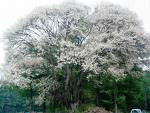
山梨や山はあるけど海はなし
yama-nashi ya yama wa aru kedo umi wa nashi
Oh mountain pears !
Yamanashi is surruonded by mountains
but not by the sea
Kawazu yori かわず より
source
http://dathimakann2.seesaa.net/article/27652144.html
This is a play on words with the kigo yamanashi, Siebold crabapple, and Yamanashi, the name of the prefecture. NASHI also means "not to have".
KIGO FOR LATE AUTUMN
yamanashi、yama-nashi 山梨 (やまなし)
"mountain nashi pear, mountain pear"
also called zumi ズミ or "mountain apple", yama ringo やまりんご.
Malus sieboldii (Regel) Rehd. / Siebold crabapple
They have small fruit which resemble the normal NASHI pears, but the fruit is not eaten.
. . . CLICK here for Photos !
konashi 小梨(こなし)small nashi pear
inu nashi, inunashi 犬梨(いぬなし) "pear for the dogs"
kigo for late spring
yamanashi no hana 山梨の花 やまなしのはな blossoms of the mountain pear
... 棠梨の花(やまなしのはな), 聖霊梨の花(やまなしのはな)
konashi no hana 小梨の花(こなしのはな)
shikanashi no hana 鹿梨の花(しかなしのはな)"blossom of the deer pear"
[ . BACK to WORLDKIGO TOP . ]
:::::::::::::::::::::::::::::::::::::::::::::::::::::::::::::::::::::::::::::::::::::::::::::::::::::
*****************************
Related words
***** WASHOKU : Regional Japanese Dishes
***** . Folk Toys from Yamanashi .
:::::::::::::::::::::::::::::::::::::::::::::::::::::::::::::::::::::::::::::::::::::::::::::::::::



